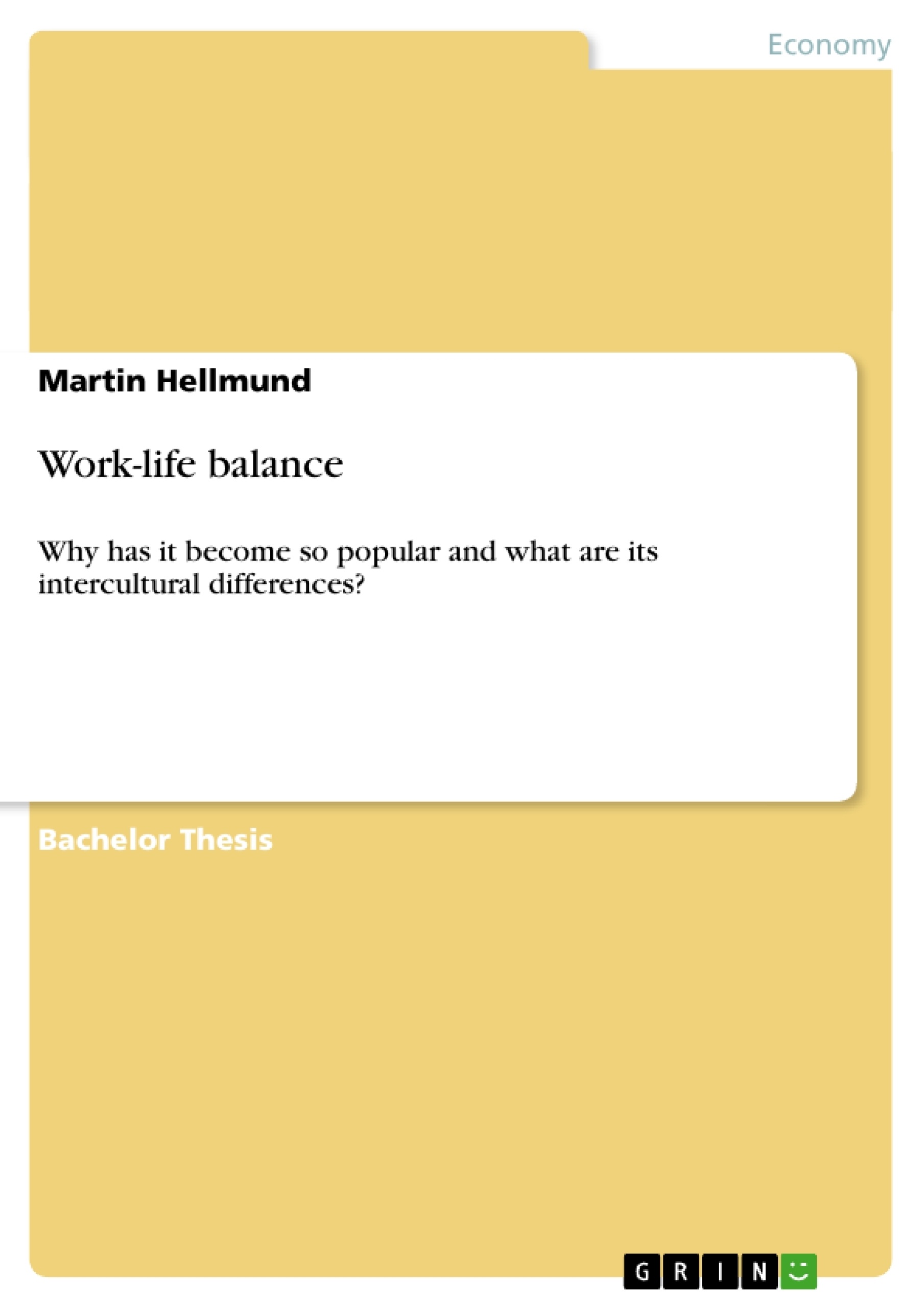Table of Contents
Abstract iii
List of Tables iv
List of Figures v
1. Introduction 1
1.1. Background to the study 1
1.2. Objectives of the study 4
1.3. Layout of the study 5
1.4. Usefulness of the study 5
2. Literature Review 6
2.1. Introduction 6
2.2. History of the term Work-life balance 6
2.3. Defining the term Work-life balance 7
2.4. The complexity of Work-life balance 10
2.5. Reasons for the increasing popularity of Work-life balance 11
2.6. Cultural Research on Work-life balance 13
3. Research Methodology 16
3.1. Introduction 16
3.2. Research Objectives 16
3.3. Research Design 17
3.5. Reliability and Validity 21
3.6. Data Analysis 22
4. Findings and Results 23
4.1. Introduction 23
4.2. The results of the U.S. questionnaire 23
4.3. German pilot study 25
5. Analysis 28
5.1. Introduction 28
5.2. Change of society 28
5.3. Demographic changes 31
5.4. Business pressures 33
5.5. Intercultural Work-life balance differences between Germany and the U.S. 33
6. Conclusions and Recommendations 37
6.1. Introduction 37
6.2. Reasons for the popularity 37
6.3. Cultural Differences 38
6.4. Limitations of the study 39
6.5. Future Research and Recommendations 39
7. References vi
8. Appendices ix
The term “Work-life balance” has become very popular over the past decades due to several reasons. For example, the demographic change
and business pressure to be the “employer of choice” in order to attract a decreasing number
of skilled workforce cause companies all around the world to offer Work-life balance policies
that aim at supporting their employees in creating a healthy and productive balance between
their working and private life.
Moreover, certain differences between cultures in terms of the employees’ Work-life balances
and the employers’ approaches to it can be noticed. As this dissertation concentrated on the
differences between the U.S. and German culture, it compared a questionnaire filled out by an
American employee working for an American company to a pilot
study of German companies. Differences were discovered in the attitude towards the Worklife
balance of the leadership within a company. Also, the offerings of sport- and leisure
facilities differed as well as family-friendly policies.
Finally, the dissertation came to the conclusion that Work-life balance policies have to be
customised to the respective culture of the employees in order to be really efficient.
Inhaltsverzeichnis (Table of Contents)
- 1. Introduction
- 1.1. Background to the study
- 1.2. Objectives of the study
- 1.3. Layout of the study
- 1.4. Usefulness of the study
- 2. Literature Review
- 2.1. Introduction
- 2.2. History of the term Work-life balance
- 2.3. Defining the term Work-life balance
- 2.4. The complexity of Work-life balance
- 2.5. Reasons for the increasing popularity of Work-life balance
- 2.6. Cultural Research on Work-life balance
- 3. Research Methodology
- 3.1. Introduction
- 3.2. Research Objectives
- 3.3. Research Design
- 3.5. Reliability and Validity
- 3.6. Data Analysis
- 4. Findings and Results
- 4.1. Introduction
- 4.2. The results of the U.S. questionnaire
- 4.3. German pilot study
- 5. Analysis
- 5.1. Introduction
- 5.2. Change of society
- 5.3. Demographic changes
- 5.4. Business pressures
- 5.5. Intercultural Work-life balance differences between Germany and the U.S.
- 6. Conclusions and Recommendations
- 6.1. Introduction
- 6.2. Reasons for the popularity
- 6.3. Cultural Differences
- 6.4. Limitations of the study
- 6.5. Future Research and Recommendations
Zielsetzung und Themenschwerpunkte (Objectives and Key Themes)
The main objective of this study is to investigate the increasing popularity of the concept of Work-life balance and to analyze its intercultural differences, specifically focusing on the United States and Germany. The study aims to uncover the driving forces behind the rise of Work-life balance policies and to identify key cultural differences in their implementation and perception.
- The increasing popularity of Work-life balance
- Cultural differences in Work-life balance perspectives
- The influence of globalization and societal changes
- Demographic shifts and their impact on Work-life balance
- Business pressures and employer strategies regarding Work-life balance
Zusammenfassung der Kapitel (Chapter Summaries)
The study begins with an introduction that provides context and outlines the objectives and scope of the research. Chapter 2 delves into a comprehensive literature review, exploring the historical development of the concept of Work-life balance, defining the term, and analyzing its increasing popularity. This chapter also examines cultural research on Work-life balance, laying the groundwork for the subsequent analysis of intercultural differences. Chapter 3 details the research methodology employed, including the research design, data collection methods, and data analysis techniques.
The study then presents the findings and results in Chapter 4. This chapter focuses on the results of the U.S. questionnaire and the German pilot study, highlighting key differences in perceptions and practices of Work-life balance between the two countries. Chapter 5 offers an in-depth analysis of these findings, examining the factors contributing to the observed differences, including societal changes, demographic shifts, and business pressures. Finally, Chapter 6 concludes the study by summarizing the key findings, highlighting the importance of cultural sensitivity in the development and implementation of Work-life balance policies, and proposing areas for future research.
Schlüsselwörter (Keywords)
This study examines the concept of Work-life balance, its increasing popularity, and its intercultural differences. Key areas of focus include globalization, societal changes, demographic shifts, business pressures, cultural research, and the comparison of Work-life balance policies in the United States and Germany. The study also explores the concept of "employer of choice" and the role of family-friendly policies in attracting skilled workers. These keywords encapsulate the central themes and research focus of the study.
- Arbeit zitieren
- Martin Hellmund (Autor:in), 2011, Work-life balance, München, GRIN Verlag, https://www.grin.com/document/203709



